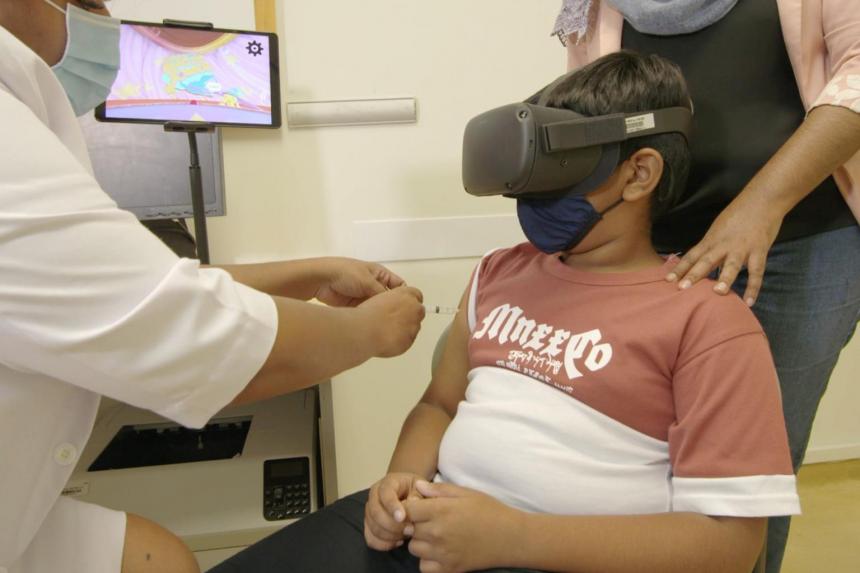
The VR software provides a distraction for children from painful medical procedures. PHOTO: SINGHEALTH POLYCLINICS
SINGAPORE - Children who get their vaccines at polyclinics may soon be given a virtual reality (VR) headset to distract them from any pain and anxiety during the vaccine administration.
The VR software, Silver, enacts a two-minute story and provides an alternative to the interactive toys and animated video clips currently used to distract children from painful medical procedures.
Once a child wears the VR headset, he or she will see a spell book with a blue crystal tower floating above. An avatar named Burp will then ask the child to assist him in powering up the crystal tower.
Burp will use his magic wand to tap the child's left shoulder to coincide with the point of injection. A rune on the child's left shoulder is then activated to enable magical power to flow from it to the crystal tower.
Nurses can view the progression of the story on a tablet to coordinate the administration of the vaccine.
Silver was developed during a pilot study in 2019 by SingHealth Polyclinics (SHP) on using VR to alleviate anxiety during child vaccination. Twenty children aged four to 10 were involved in choosing the avatar design of Burp.
The team also worked with scientists from the National Institute of Education and experienced nurses to develop a storyline that keeps children engag
During a virtual media briefing on Tuesday (May 17), Dr Chang Zi Ying, associate consultant and clinic director of SHP-Sengkang, said: "As opposed to watching a YouTube video on iPad where the child can still be aware of the nurses and the needles, VR application completely immerses the child into another simulated environment, which reduces the pain signal."
The study recruited another group of 30 children aged four to 10 at SHP-Sengkang.
They were randomly assigned to an intervention group or a control group of 15 children each.
Children in the intervention group donned the VR headset to view the VR animation while a vaccine was being administered, and those in the control group went through their immunisation without viewing the VR animation.
The results showed a significant reduction in the anxiety score of the children in the intervention group compared with the control group.
However, there were no significant differences in the pain scores between both groups, possibly due to the small number of participants in the pilot study, said the research team.
The anxiety score of accompanying parents also fell significantly in the intervention group compared with the control group.
There were no significant differences in the anxiety level of the nurses in both groups.
Dr Chang said the results show the feasibility of using such technology in childhood immunisation.
The study was published in the journal of Frontiers In Paediatrics in March.
The team plans to expand the study to younger and older age groups, as well as those who have needle phobia.
Clinical Associate Professor Tan Ngiap Chuan, who is director of research at SHP, said: "We may also consider developing a variety of software, so that children can experience fresh VR journeys every time they come for vaccinations."













 Get it on Google Play
Get it on Google Play